The MUTCD (Manual on Uniform Traffic Control Devices) from the Federal Highway Administration (FHWA) is adopted by US law as the set of requirements for traffic signs, signals, and road markings in the US.
2009 MUTCD: Non-metric and no metric signs
The 2009 edition of the MUTCD, effective 15 January 2010 and announced in the 16 December 2009 Federal Register, uses only non-metric measurements in text, figures, and tables, but includes an appendix that provides metric equivalents for measurements used in the MUTCD. This is a change from the previous, 2003 edition, which used dual units with metric first.
FHWA’s analysis and rationale
“The FHWA received several comments regarding the use of metric units in the MUTCD. The NCUTCD [National Committee on Uniform Traffic Control Devices], six State DOTs, ATSSA [American Traffic Safety Services Association], an NCUTCD member, and two traffic engineering consultants suggested that the metric units be removed in their entirety or that the English units precede the metric units, and a traffic engineering consultant suggested that the MUTCD continue to be issued with both systems of measurement.
“Because metric units are not currently used in the U.S. for traffic control device applications, the FHWA determines that only English units are to be used in the MUTCD text, figures, and tables and places metric equivalent values for all English unit values used in the MUTCD in a new Appendix A2 in this final rule. This preserves the soft conversions of the English to metric values in the MUTCD while also providing a document that is less cumbersome to read and apply. This change is consistent with an Informational Memorandum from FHWA’s Executive Director, dated November 25, 2008, stating that use of metric measurements will now be optional in all FHWA documents, including letters, memoranda, publications, reports, and information on FHWA Web sites.”
Effect on road signs
In addition to the aforementioned change, the 2009 MUTCD no longer includes metric unit symbols in the table of acceptable abbreviations for use on road signs and no longer includes metric signs. Although most metric signs were identical to non-metric versions except for unit symbols, the 2003 MUTCD included two metric-specific signs: one for metric speed limits and a “METRIC” plaque intended primarily to accompany metric weight limit signs.
For historical purposes, the section below explains the metric signs in the 2003 edition of the MUTCD.
2003 MUTCD metric road signs
Although the 2003 MUTCD used metric measurements, it didn’t specifically require or forbid metric road signs. However, the MUTCD did specify the format of metric road signs, when used, and some examples are shown below.
Most metric signs resemble non-metric signs
Except for speed limits, metric signs generally look just like their non-metric counterparts except for the units, which are written in the usual way:
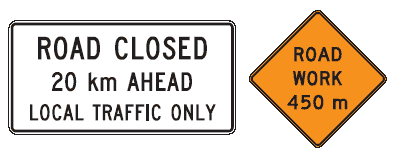
Note that words on signs — except for names of places and streets — are generally required to be all-caps. An exception (although seemingly not explicit) is made for metric unit symbols.
Following are some examples of metric signs from the MUTCD.
Speed limit signs
Speed limits are in multiples of 10 km/h and look like the leftmost sign below. If there’s a special speed limit for trucks or the like, an additional sign is included below the first, and similarly if there’s a different night speed limit. The signs can be combined in the same panel.

History of metric speed limit signs
If you’re wondering why the US isn’t using the European style speed limit sign, which looks like this,
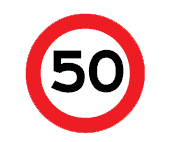
here’s the story.
The original US metric speed limit sign, in the 2000 MUTCD, looked exactly like non-metric speed limit signs. As a result, it required supplemental “metric” and “km/h” plaques so you could tell the difference:
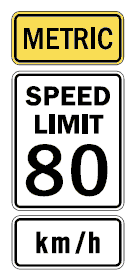
In 2002, the FHWA proposed replacing that three-part sign with a single sign using a red circle around the speed limit and a “km/h” legend below. (The proposal also mentions a sign using a green circle, but I believe that was a typo.)
However, comments on the proposal expressed concern that a red circle is generally associated with a prohibitory regulatory message, and that a speed limit doesn’t fall into that category of message.
So, in 2003 the FHWA decided against the color red but in favor of the concept of placing a circle around a metric speed limit, to provide a clear and easily noticed distinction between metric and non-metric speed limit signs, and changed the color of the circle to black.
Minimum speed limit signs
If there’s a minimum speed limit, a sign like the one below is installed below a speed limit sign. Alternatively, both are combined in a sign like the one on the right.
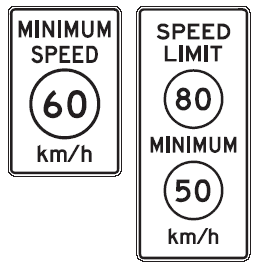
Advisory speed limit signs
The advisory speed plaque on the left is used to supplement a warning sign, while the advisory exit, ramp, and curb speed signs may stand alone.
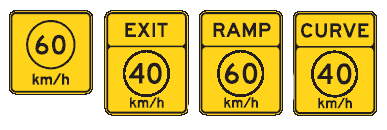
Combination horizontal alignment/advisory speed signs
A turn or curve sign can be combined with an advisory speed sign like this:
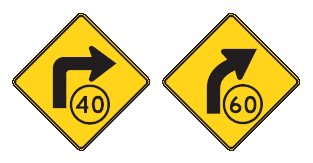
Weight limit signs
Weight limit signs resemble the examples below.
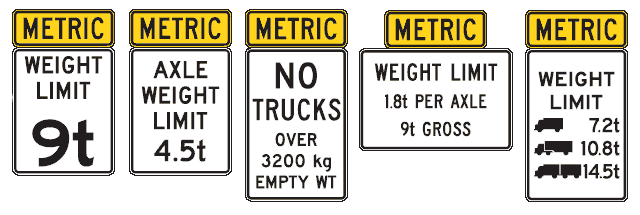
On road signs, note that a capital T is the symbol for (non-metric) tons, while a lowercase t is the symbol for metric tons.
Low clearance signs
Low clearance signs show clearances less than 300 mm above the statutory maximum vehicle height, and should show the clearance to the nearest 25 mm (rounded down, of course). The sign on the right is a variant that can be used when mounted on the structure itself.
Reference location signs
Reference Location signs — kilometer posts — show integral kilometers if they’re installed only at integral kilometer distances:
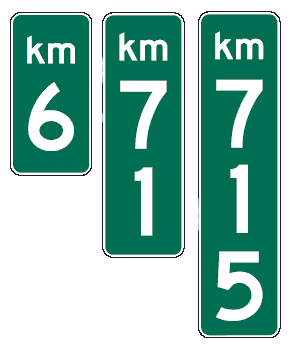
Alternatively, “Intermediate Reference Location” signs, which include one decimal place, may be installed at intervals of 0.1 km or a multiple thereof. In this case, the kilometer posts at integral kilometers must include a decimal point and zero.
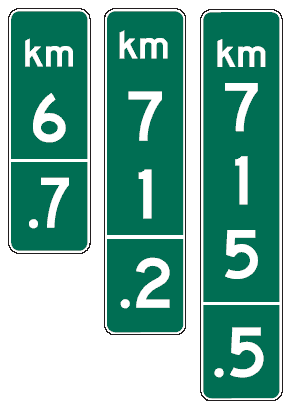
Finally, “Enhanced Reference Location” signs include the route number:
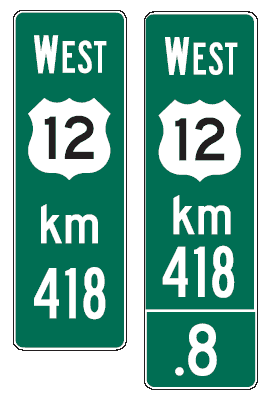
Kilometer post distances, like milepost distances, are measured from the south or west state line, or the south and west terminus points of the route within the state, measured on the northbound or eastbound side of the road, with identical signs posted directly opposite on the southbound or westbound lanes.
Back to USMA home.
Copyright © 2002–2009, US Metric Association (USMA), Inc. All rights reserved.
This page prepared by USMA member Gary Brown.
Updated: 2009-12-16